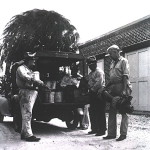SciTech Tuesday: Zyklon B
On June 20, 1922 a German company filed for a patent on a new formulation of a pesticide/insecticide, which it called Zyklon B (zyklon is German for cyclone).
After its first use as a pesticide in California citrus plantations in the late 19th century, hydrogen cyanide came to be used in all sorts of circumstances as a fumigant. In the US it was used to fumigate train cars, the clothes of immigrants, and in Germany it was used to kill lice and rats. In World War I, a form of hydrogen cyanide, known as Zyklon, used as a chemical weapon by the German military.
After World War I, this form of hydrogen cyanide was banned. The scientists at a German chemical company came up with a new formulation, getting the cyanide from the waste products of sugar-beet production, and packaged the hydrogen cyanide with diatomaceous earth in a canister, along with a chemical irritant to warn of the product’s toxicity. They called it Zyklon B to differentiate it from the earlier, banned, product. From 1922 to the start of the war, most of the sales came from outside of Germany.
Hydrogen cyanide is a very potent toxin. It binds with the iron compound in an enzyme called cytochrome c oxidase in cells. This enzyme is necessary in production of adenosine triphosphate (ATP), which is required by cells in energy transfer. Without ATP cells cannot survive, and without cytochrome c oxidase cells can’t make ATP. Hydrogen cyanide reacts with cytochrome c oxidase and keeps it from making ATP. In aerial forms, such as Zyklon B, it enters the body quickly. In a human of about 150 lbs only 70 milligrams of Zyklon B can be fatal in 2 minutes.
In 1941 the German SS was experimenting with methods of efficiently killing prisoners. A captain tested Zyklon B on a group of Russian POWs at Auschwitz in a building basement. By early 1942 Zyklon B became the SS’s preferred method for killing prisoners and was used to kill at least 1 million prisoners. Many of these were at Auschwitz, where the practice originated.
Two of the scientists who developed managed Zyklon B production were tried and executed in British military court for knowingly delivering the chemical to kill prisoners. Different forms of hydrogen cyanide are still used today as pesticides.
- Hydrogen cyanide, while highly toxic, is a simple combination of three common and essential elements of life: Hydrogen, Carbon, and Nitrogen.
- Hydrogen cyanide binding to an Iron atom, as it does in Prussian Blue
- A scene from 1939 New Orleans--men about to fumigate a warehouse with Zyklon B.
Posted by Rob Wallace, STEM Education Coordinator at The National WWII Museum.
all images from Wikimedia Commons







Leave a Reply